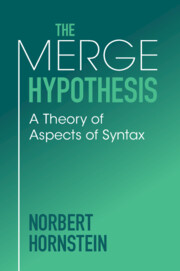Book contents
- The Merge Hypothesis
- The Merge Hypothesis
- Copyright page
- Contents
- Preface
- Abbreviations
- Introduction
- 1 A Whig History of Generative Grammar
- 2 Tools and Particulars
- 3 Adding Labels
- 4 Construal and the Extended Merge Hypothesis (1)
- 5 Construal and the Extended Merge Hypothesis (2)
- 6 A Partial Wrap-Up and Segue
- 7 Labels
- 8 Odds and Ends
- 9 Conclusion
- Bibliography
- Index
7 - Labels
Published online by Cambridge University Press: 15 February 2024
- The Merge Hypothesis
- The Merge Hypothesis
- Copyright page
- Contents
- Preface
- Abbreviations
- Introduction
- 1 A Whig History of Generative Grammar
- 2 Tools and Particulars
- 3 Adding Labels
- 4 Construal and the Extended Merge Hypothesis (1)
- 5 Construal and the Extended Merge Hypothesis (2)
- 6 A Partial Wrap-Up and Segue
- 7 Labels
- 8 Odds and Ends
- 9 Conclusion
- Bibliography
- Index
Summary
This chapter argues that labeling is the key linguistically bespoke operation. I trace the recursive property of Gs to the fact that they employ labels. The chapter argues that labels are the device for taking an expression in the range of Merge and putting it into the domain of Merge. Thus labels close Merge in the domain of the lexical atoms. So closing the operation effectively delivers a recursive system of unbounded hierarchy. The chapter also critically reviews some arguments for the simplicity of Merge based on the role it is intended to play in explaining the evolution of language. I dispute this and argue that what needs explanation is something quite different: What is the source of the power to form inductive definitions? Recursion is a consequence of closure afforded by labels.
Keywords
Information
- Type
- Chapter
- Information
- The Merge HypothesisA Theory of Aspects of Syntax, pp. 184 - 206Publisher: Cambridge University PressPrint publication year: 2024
